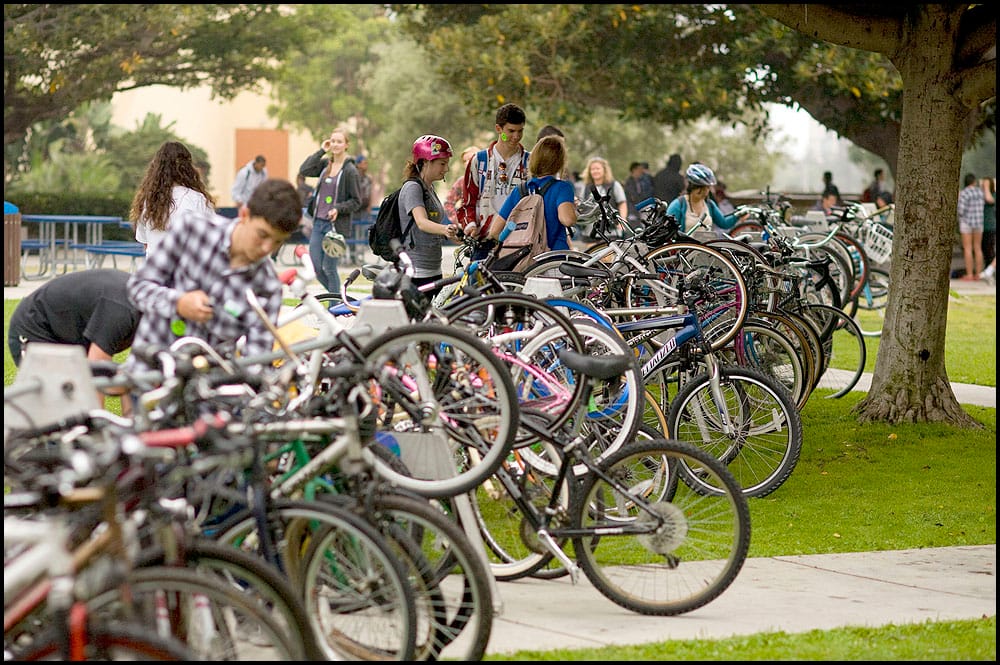
City officials are reviewing concepts for a Michigan Avenue Neighborhood Greenway, or MANGO. LEMON would be a better acronym.
MANGO is a plan to convert Michigan Avenue and adjoining streets in the Pico Neighborhood (including portions of Delaware and Virginia avenues) into a more bike and pedestrian friendly byway from Ocean Avenue on the western end to the Bergamot Station Expo Light Rail station and Expo Bike and Pedestrian Path on the eastern end.
According to the Aug. 28 staff report, MANGO, "would provide residents and visitors with a safe and comfortable place to walk, bike, and interact with neighbors, all while connecting the community to important destinations including schools, job centers, and future Expo stations." As if this mostly quiet residential neighborhood isn't safe and comfortable, already.
MANGO contains the usual elements — "roadway calming, increased landscaping, sidewalk widening, bike facilities, and enhanced crosswalks … The project will make it easier to get around Santa Monica on foot and by bicycle, and is intended to enhance the livability of the neighborhood and improve environmental quality."
Many neighbors strongly disagree. Achieving this could mean narrowing or removing Michigan's traffic lanes from Santa Monica High School to 20th Street. Among the options being considered are making most of Michigan Avenue one way (east to west) and installing traffic roundabouts at key intersections.
By far and away, the worst aspect of this proposal is removal of high-demand parking space on one side of the street. With many older apartment buildings underparked — especially with multiple tenants in apartments each owning cars, street parking is a scare commodity.
Fear not, City Hall planners have an answer: Create diagonal parking on some intersecting side streets to create more parking space. This also involves narrowing or removing traffic lanes to accommodate the diagonal parking and it also means less safe space for bicycle riders.
City staff reports these days are mostly a mix of fiction and/or propaganda. My favorite MANGO benefit is this gem: "1 in 4 SMMUSD students residing in 90404 were unable to pass at least 4 of 6 State physical fitness tests, which is the highest of the City's ZIP codes. Providing more opportunities for active transportation will work toward reversing this."
Wow! We're going to redo most of the Pico Neighborhood so school kids can get more exercise? I thought that's what parks and sports programs were for.
Lest I be accused of being anti-bicycle, let me say that I'm all for bike access. But, bicycles can share traffic lanes. Traffic lanes on quiet residential streets such as Michigan and others included in the greenway plan should clearly be marked for shared use by bicycles.
Traffic, parking and neighborhood access should not be disrupted by the installation of exclusive bicycle lanes with barricades between bike riders and the rest of the street. Michigan is a public street, not a linear playground.
By the way, I can't help but think what kind of a hullabaloo would result if City Hall bureaucrats proposed removing street parking, eliminating traffic lanes and installing wider sidewalks and constructing exclusive, barricaded bike lanes on Alta, Carlisle, Margarita or Georgina avenues on the city's north side.
Sharing the space makes sense. If we think smart, we can have the best of both worlds, but the folks in the Pico Neighborhood, especially along MANGO's path, should not be denied parking or convenient access to their homes.
Bergamot Area Plan is a scam
Coming up tomorrow is the City Council's adoption of review of the Bergamot Area Plan. The plan is supposed to provide a realistic blueprint for development and growth in these formerly industrial lands which are now the target du jour for extensive housing, office and transit elements. Directing staff to begin negotiating development agreements based on the adopted plan is also included.
Problem is that the Bergamot Plan is deeply flawed and negotiating development agreements on it will lead to major planning failures.
One problem is that the number of housing units projected for new developments in the plan area have already exceeded the city's Land Use and Circulation Element (LUCE) projections for 2030 — and there's more, lots more, to come. This occurrence alone should trigger the need for a new environmental impact report because key LUCE thresholds have been surpassed.
Another key LUCE "fantasy" goal of "no new net trips" has zero chance of being met with the estimated 20,000 additional weekday car trips expected from recently completed and approved developments as well as pending developments including the Bergamot Transit Village Center development on the old Paper Mate site.
Speaking of the Bergamot area, isn't developer Hines calculating the new streets proposed for the site as part of its floor area ratio (FAR)? This little trick give Hines extra density. Only buildable land should be used in determining FAR. The project is before the Planning Commission on Wednesday.
City planners and developers alike see the Bergamot area as one place to put lots of new housing to help correct what planners and politicos alike claim is a jobs/housing imbalance.
Now they're going to correct the imbalance by adding lots more development under the belief that people who work here will also live here if they can afford it and vice versa. That's a big "if." Or, that people who reside here will never change jobs and work out of town.
All of this will exacerbate traffic, congestion and crowding. The current Bergamot Area Plan is a bogus way to justify the unjustifiable and facilitate irresponsible development.
Bill can be reached at mr.bilbau@gmail.com.

